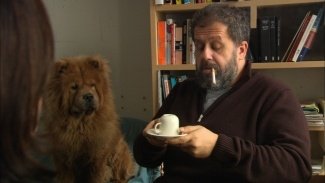For the blind man in the dark room...
dal 11/2/2010 al 27/3/2010
Segnalato da
Anonymous
Dave Hullfish Bailey
Marcel Broodthaers
Bryssinck & Peeters
Patrick van Caeckenbergh
Sarah Crowner
Mariana Castillo Deball
Eric Duyckaerts
Ger van Elk
Ayse Erkmen
Hans-Peter Feldmann
Peter Fischli & David Weiss
gerlach en koop
Rachel Harrison
Matt Mullican
Bruno Munari
Nashashibi/Skaer
Falke Pisano
Jimmy Raskin
Frances Stark
Rosemarie Trockel
David William
Anthony Huberman
11/2/2010
For the blind man in the dark room...
De Appel Boys' School, Amsterdam
On the occasion of the inauguration of the new exhibition venue 'de Appel Boys' School' de Appel presents a group exhibition celebrates the experience of curiosity and speculation as a form of knowledge. In this exhibition, viewers stop being passive receivers of information and become active participants in a playful spirit of inquiry.

Participating artists:
Anonymous, Dave Hullfish Bailey (US), Marcel Broodthaers (BE),
Bryssinck en Peeters (BE), Patrick van Caeckenbergh (BE), Sarah
Crowner (US), Mariana Castillo Deball (MX), Eric Duyckaerts (BE),
Ayse Erkmen (TU), Hans-Peter Feldmann (DE), Peter Fischli & David
Weiss (CH), gerlach en koop (NL), Rachel Harrison (US), Giorgio
Morandi (IT), Matt Mullican (US), Bruno Munari (IT), Nashashibi/Skaer
(UK), Falke Pisano (NL), Jimmy Raskin (US), Frances Stark (US),
Rosemarie Trockel (DE) and David William (US/UK)
Curated by Anthony Huberman, chief curator of the Contemporary Art
Museum St. Louis (US), i.c.w. Ann Demeester (BE)
‘I know that I know nothing.’
Socrates
‘A mathematician is like a blind man in a dark room looking
for a black cat that isn’t there.’
Attributed to Charles Darwin
On the occasion of the move to ‘de Appel Boys’ school’ on the Eerste
Jacob van Campenstraat 59 in the Pijp district of Amsterdam, de Appel
put on the group exhibition, “For the blind man in the dark room
looking for the black cat that isn’t there”. This group exhibition
celebrates the experience of curiosity and speculation as a form of
knowledge.
The title was taken from a remark attributed to Charles Darwin (1809-
1882), the father of the theory of evolution, who apparently compared
mathematics to research by a blind man. In his scientific discipline
Darwin attempted to categorise the natural world in a comprehensible
way, while he maintained that mathematics was merely concerned with
abstractions and was not related to reality in any way. In contrast
with Darwin, this exhibition chose to take the part of the proverbial
blind man who had the courage to seek in the dark for what may be unfindable. It is an argument for curiosity and speculation as a way of
understanding the world and acquiring knowledge. Artists can help us
with this. In contrast with science and philosophy, art teaches us
that it can be productive to occasionally let go of the knowledge and
certainty that have been acquired.
An extensive installation by Matt Mullican, consisting of drawings,
flags, diagrams, rubbings, photographs and prints, demonstrated the
artist’s completely subjective ‘theory of everything’. Many of the
works in the exhibition presented persistent or paradoxical searches
for knowledge, while in a series of slides Bruno Munari tirelessly
tried to make himself comfortable in an uncomfortable chair. In an
audio recording dating from 1970, Marcel Broodthaers asked his cat
questions about painting. In a romantic Swiss alpine landscape Peter
Fischli & David Weiss reflected on existential questions, morality
and aesthetics, dressed as a bear and a rat.
The contributing artists each pursue a better understanding of the
world, but also insist that an artwork isn't an explanation and that
art is not a code that has to be unlocked. Art is not only and exclusively accessible to the initiated, as long as you can accept that it
does not always have to be explained or understood straightaway. Artists sometimes ask us to perceive things in a different way and not
to be afraid to leave well-trodden paths. The exhibition presented a
number of bold dogmas which revealed that a particular attitude is
more important than factual knowledge: be curious, keep on thinking,
and don’t always try to understand everything.
The exhibition was curated by Anthony Huberman, the chief curator of
the Contemporary Art Museum of St. Louis in the USA, in collaboration
with Ann Demeester (director of the Appel). Following presentations
in the Contemporary Art Museum of St. Louis, the Institute of Contemporary Art in London, and the Detroit Museum of Contemporary Art, the
exhibition will be given a new form in the Appel. This stage in the
relay concluded with an exhibition in the Culturgest in Lisbon.
A book was published with the exhibition, written by Anthony Huberman, composed and designed by Will Holder, and with contributions
from Marcel Broodthaers, Sarah Crowner, Eric Duyckhaerts, Hans-Peter
Feldmann, Fischli & Weiss, Giorgio Morandi, Rachel Harrison,
Rosemarie Trockel and Patrick van Caeckenbergh.
Events in the context of the Exhibition:
(Free entry with an entrance ticket for the exhibition, reservation required via reservation@deappel.nl)
13 Febr. From 5 pm onwards:
Lecture by curator Anthony Huberman
Film Screening Performance Bryssinck & Peeters
21 February and 21 March, 5 pm
Free Guided Tours throughout the exhibition
28 March Finissage
2pm. Mariana Castillo Deballs 'piñata bashing ceremony';
3pm. Guided tour of the exhibition;
4pm. Sunday school: one work from the exhibition becomes the subject of a close reading by an expert viewer
Image: Ayse Erkmen, "Coffee", 2006, Video, 25 min.
For more information please contact Hiske Zomer via
Hzomer@deappel.nl or +31(0) 20 6255651
The inauguration of 'de Appel Jongensschool' & Opening of
the Group Exhibition: 12 February 2010, 6 pm.
'de Appel Boys' School'
Eerste Jacob van Campenstraat 59, Amsterdam



